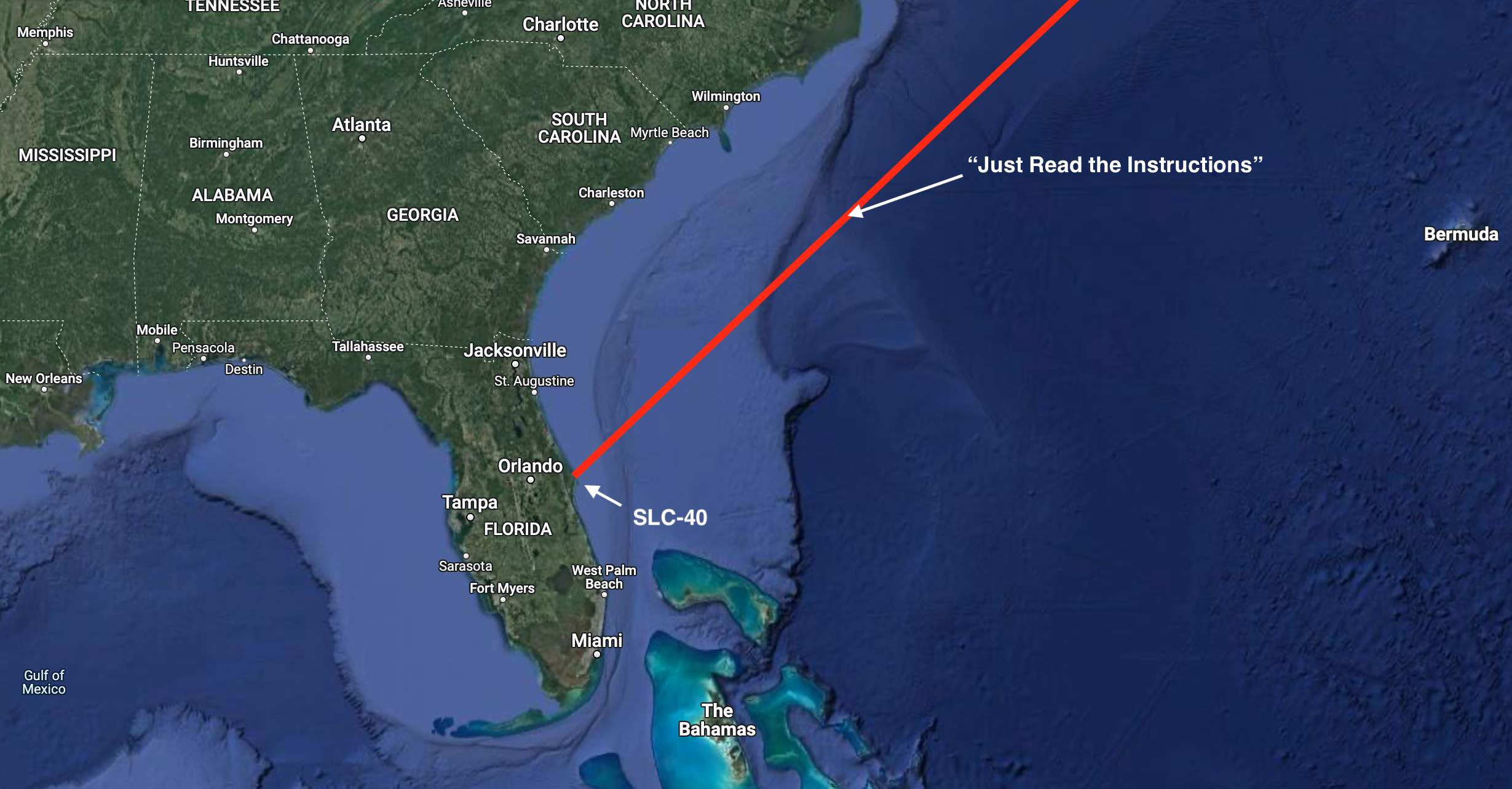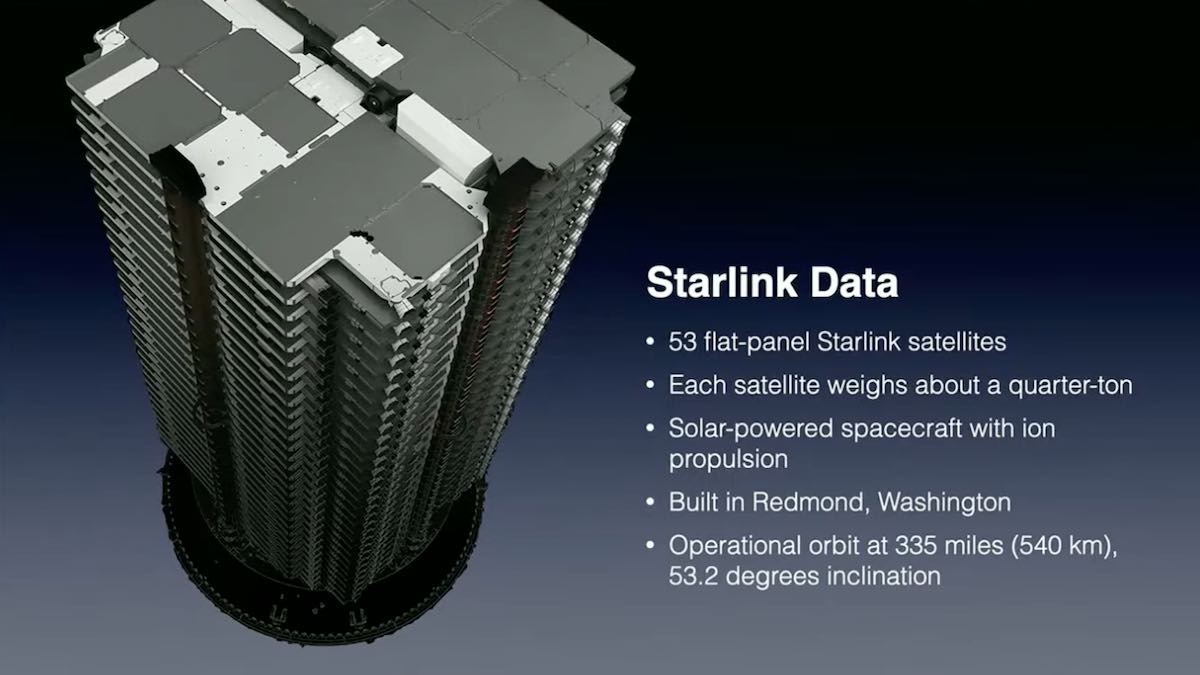Live coverage of the countdown and launch of a SpaceX Falcon 9 rocket from Space Launch Complex 40 at Cape Canaveral Space Force Station in Florida. The Starlink 4-15 mission will launch SpaceX’s next batch of 53 Starlink broadband satellites. Follow us on Twitter.
SFN Live
Less than 24 hours after launching Starlink satellites from California, SpaceX is set to loft another 53 internet relay stations a 4:40 p.m. EDT (2040 GMT) Saturday from Cape Canaveral aboard a Falcon 9 rocket. It will be SpaceX’s 20th launch of the year, and the second of 2022 to debut a new Falcon 9 booster.
The booster will target a landing on SpaceX’s drone ship “Just Read the Instructions” floating in the Atlantic Ocean northeast of Cape Canaveral.
SpaceX plans to complete preparations on the Falcon 9 rocket Saturday, and begin loading super-chilled, densified kerosene and liquid oxygen propellants into the 229-foot-tall (70-meter) vehicle at T-minus 35 minutes.
Helium pressurant will also flowed into the rocket in the final half-hour of the countdown. In the final seven minutes before liftoff, the Falcon 9’s Merlin main engines will be thermally conditioned for flight through a procedure known as “chilldown.” The Falcon 9’s guidance and range safety systems will also be configured for launch at 4:40:50 p.m.
The 229-foot-tall (70-meter) Falcon 9 rocket will vector its 1.7 million pounds of thrust — produced by nine Merlin engines — to steer northeast over the Atlantic Ocean.
The rocket will surpassed the speed of sound in about one minute, then shut down its nine main engines two-and-a-half minutes after liftoff. The booster will drop away from the Falcon 9’s upper stage, then fire pulses from cold gas control thrusters and extend titanium grid fins to help steer the vehicle back into the atmosphere.
Two braking burns will slow down the rocket for landing on the drone ship around 400 miles (650 kilometers) downrange approximately eight-and-a-half minutes after liftoff.

The booster — tail number B1073 — is set for launch on its first mission Saturday. The landing of the first stage will occur just prior to shutdown of the upper stage engine. The rocket will coast halfway around the world before reigniting the Merlin-Vacuum upper stage engine about 45 minutes into the mission, paving the way for separation of the 53 Starlink satellites at T+plus 54 minutes, 32 seconds.
Retention rods will release from the Starlink payload stack, allowing the flat-packed satellites to fly free from the Falcon 9’s upper stage in orbit. The 53 spacecraft will unfurl solar arrays and run through automated activation steps, then use krypton-fueled ion engines to maneuver into their operational orbit.
The Falcon 9’s guidance computer will aim to deploy the satellites in a near-circular orbit ranging in altitude between 189 miles and 197 miles (305 by 318 kilometers), at an orbital inclination of 53.2 degrees to the equator. The satellites will use on-board propulsion to do the rest of the work to reach a circular orbit 335 miles (540 kilometers) above Earth.
The Starlink satellites on Saturday’s mission will fly in one of five orbital “shells” used in SpaceX’s global internet network. After reaching their operational orbit, the satellites will enter commercial service and begin beaming broadband signals to consumers, who can purchase Starlink service and connect to the network with a SpaceX-supplied ground terminal.

After Friday’s mission, SpaceX will have launched 2,600 Starlink satellites to date, including spacecraft that were decommissioned or suffered failures. More than 2,200 of those satellites are in orbit and functioning as of this week, according to a list maintained by Jonathan McDowell, an astrophysicist who closely tracks spaceflight activity.
Read our mission preview story for more details.
ROCKET: Falcon 9 (B1073.1)
PAYLOAD: 53 Starlink satelllites (Starlink 4-15)
LAUNCH SITE: SLC-40, Cape Canaveral Space Force Station, Florida
LAUNCH DATE: May 14, 2022
LAUNCH TIME: 4:40:50 p.m. EDT (2040:50 GMT)
WEATHER FORECAST: 80% chance of acceptable weather; Low risk of upper level winds; Low risk of unfavorable conditions for booster recovery
BOOSTER RECOVERY: “Just Read the Instructions” drone ship east of Charleston, South Carolina
LAUNCH AZIMUTH: Northeast
TARGET ORBIT: 189 miles by 197 miles (305 kilometers by 318 kilometers), 53.2 degrees inclination
LAUNCH TIMELINE:
- T+00:00: Liftoff
- T+01:12: Maximum aerodynamic pressure (Max-Q)
- T+02:34: First stage main engine cutoff (MECO)
- T+02:37: Stage separation
- T+02:44: Second stage engine ignition
- T+02:50: Fairing jettison
- T+06:23: First stage entry burn ignition (three engines)
- T+06:37: First stage entry burn cutoff
- T+07:59: First stage landing burn ignition (one engine)
- T+08:24: First stage landing
- T+08:50: Second stage engine cutoff (SECO 1)
- T+45:29: Second stage restart
- T+45:31: Second stage engine cutoff (SECO 2)
- T+54:32: Starlink satellite separation
MISSION STATS:
- 154th launch of a Falcon 9 rocket since 2010
- 162nd launch of Falcon rocket family since 2006
- 1st launch of Falcon 9 booster B1073
- 134th Falcon 9 launch from Florida’s Space Coast
- 86th Falcon 9 launch from pad 40
- 141st launch overall from pad 40
- 67th flight of a new Falcon booster
- 46th dedicated Falcon 9 launch with Starlink satellites
- 20th Falcon 9 launch of 2022
- 20th launch by SpaceX in 2022
- 19th orbital launch based out of Cape Canaveral in 2022
Email the author.
Follow Stephen Clark on Twitter: @StephenClark1.
from Spaceflight Now https://ift.tt/vrUIHsk
via World Space Info







0 comments:
Post a Comment